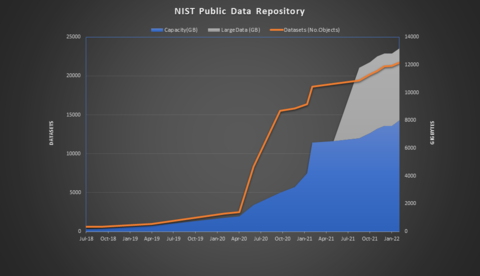Who We Are

Growth in data deposits in the NIST repository from July 2018 to January 2022.
In 2014, we published our “Plan for Providing Public Access to the Results of Federally Funded Research” and relevant directives, but we needed infrastructure to execute the plan and allow staff to comply with our policy.
Initial work of the Special Programs Office, the Office of Data and Informatics in the Materials Measurement Laboratory, the Office of Information Systems Management, and the Information Services Office focused on providing systems to address the immediate requirements of OMB and OSTP, i.e., provide an inventory of our research data assets. We provide access to research data through a system we named MIDAS. MIDAS can be used to generate data management plans, collect records for our enterprise data inventory (EDI), and send information about those records to data.gov and data.nist.gov. MIDAS is also used to inventory our open-source code. Using an application programming interface (API) to an external provider, MIDAS is able to assign digital object identifiers (DOIs) to NIST datasets and code. MIDAS can also generate a README file. Data can be stored independently or uploaded through MIDAS and securely stored in our Public Data Repository (PDR). The PDR automatically creates landing pages that are returned through the ‘search’ feature of our data portal. The data ‘author’ can edit the landing page while seeing the same view that the public will see. The PDR also generates a citation that data users can reference in their papers, and provides metrics for the number of times the data was downloaded and the number of unique users.
Our systems have been purposely constructed to be modular. As needs and technology evolve and new services are required, a component can be added, subtracted, or replaced. A few years after MIDAS was developed, we updated the NIST Publications System (NPS) in which we review papers and store publication records. Taking advantage of this new review system, in December 2021, we connected it to MIDAS so that reviews of papers, data, and software occur in a single system. Like MIDAS, NPS uses an API to communicate with an external provider of DOIs; in the case of NPS, this communication allows NIST to access author DOIs, known as ORCIDs. MIDAS and the Public Data Repository also take advantage of this service.
Initial work also focused on making cloud-based tools available that would simplify collaboration among intramural and extramural researchers. Through prioritization of these tools by a NIST-wide steering group and subsequent authorization to operate (ATO) by NIST’s Office of Information Systems Management, tools for file storage and sharing, authoring papers, code development, video conferencing, and team communications were deployed at NIST.
Contacts
-
(301) 975-3121

